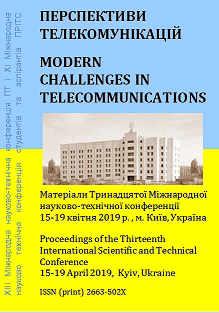ПЕРСПЕКТИВИ ПОБУДОВИ ЕКОЛОГІЧНО БЕЗПЕЧНИХ МЕРЕЖ ПЕРЕДАЧІ ДАНИХ З ВИКОРИСТАННЯМ ТЕХНОЛОГІЇ LIFI
Ключові слова:
БЕЗПРОВОДОВА МЕРЕЖА, LiFiАнотація
Prospects for the construction of environmentally
friendly data networks using the technology LIFI
The possibility of deployment LiFi network system at the PHY layer are considered. Merits and drawbacks of implementation of the wireless network based on LiFi technology are given.
Розглянуто можливість розгортання системи LiFi мережі на фізичному рівні. Наведено переваги та недоліки впровадження бездротової мережі на основі технології LiFi.
Посилання
Institute of Electrical and Electronics Engineers (IEEE), Standard for Local Area Networks, 802.15.7 IEEE, 2011.
Harald Haas, Liang Yin, Yunlu Wang, and Cheng Chen, “What is LiFi?”, Journal of lightwave technology, 0733-8724, 2015 IEEE.
O.I. Romanov, Y.S. Hordashnyk, T.T. Dong. “Method for calculating the energy loss of a light signal in a telecommunication Li-Fi system” // UkrMiCo, 2017, Odessa - IEEE Xplore Digital Library, DOI: 1109/UkrMiCo.2017.8095404, 2017. – P. 1-7.
Романов О.І., Федюшина Д.М., Донг Т.Т. Використання технології VLC для побудови мереж LI-FI та принцип її практичної реалізації. Матеріали 12-ої МНТК «Проблеми телекомунікацій», Київ, 2018 р. С 92-94. http://conferenc.its.kpi.ua/proc/article/view/129662
Svilen dimitrov, German Aerospace Center (DLR), Harald Has, “Principles of LED Light Communications Towards Networked Li-Fi”, Cambridge University Press 2015.
MohammedS.A. Mossaad, SteveHranilovic, and LutzLampe, “Visible Light Communications Using OFDM and Multiple LEDs”, 0090-6778 (c) 2015 IEEE.
##submission.downloads##
Як цитувати
Номер
Розділ
Ліцензія
Авторське право (c) 2019 Іван Олегович Сайченко, Олександр Іванович Романов, Tho Thi Dong

Ця робота ліцензується відповідно до Creative Commons Attribution 4.0 International License.
Authors who submit to this conference agree to the following terms:a) Authors retain copyright over their work, while allowing the conference to place this unpublished work under a Creative Commons Attribution License, which allows others to freely access, use, and share the work, with an acknowledgement of the work's authorship and its initial presentation at this conference.
b) Authors are able to waive the terms of the CC license and enter into separate, additional contractual arrangements for the non-exclusive distribution and subsequent publication of this work (e.g., publish a revised version in a journal, post it to an institutional repository or publish it in a book), with an acknowledgement of its initial presentation at this conference.
c) In addition, authors are encouraged to post and share their work online (e.g., in institutional repositories or on their website) at any point before and after the conference.

